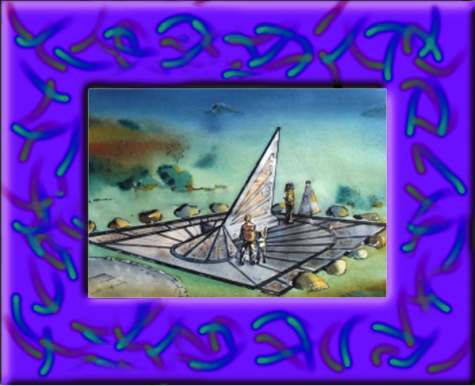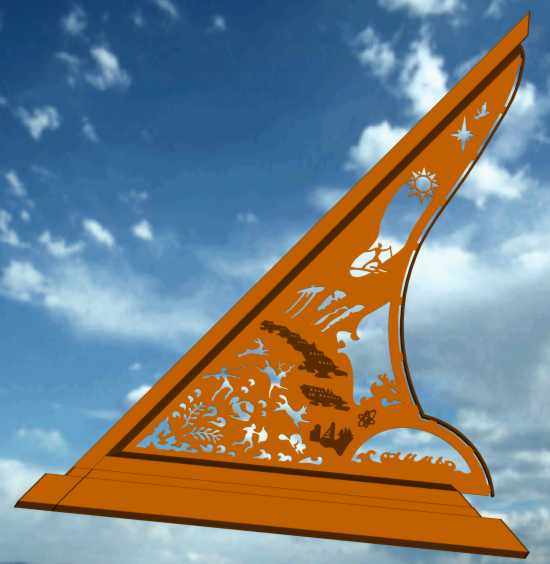
| HOME |
| SUNDIAL |
| SITE |
| THE PROJECT |
| MY DIAL |
| FUNDRAISING |
| LINKS |
|
||||||
|
| Gnomon |
| The
gnomon of the Pinawa Heritage Sundial is
approximately 16.5 ft. along its base and 17.75
ft. high. It is constructed entirely of mild
steel. It rises from the earth on a 12 in. x 12
in. hollow steel section. Above this is a 4 in. x
8 in. hollow steel section. The frame of the
gnomon which forms an angle equal to the latitude
of the sundial's location is constructed of two 6
in. x 6 in. hollow steel sections. The gnomon arm
is approximately 22 ft. long. The gnomon sail is constructed from 0.5 in. mild steel except for the four symbols located to the right of the wildlife symbols. These four symbols are made from 0.25 in. mild steel. The sail was constructed by cutting the symbols out of the 0.5 in. steel using a plasma cutter. The 0.25 in. mild steel symbols were also plasma cut but are welded to the surface of the thicker plate. There are two sets of these symbols, one for each side of the gnomon. Strips of 0.125 in. mild steel 3.5 in. wide were rolled to form a curved surface. These strips are used to frame the 0.5 in. plate and give it a more pleasing appearance. The edge of the plate is stiffened by welding a 1 in. x 3 in. length of mild steel bar stock to tabs which were plasma cut as part of the main plate. When the construction of the gnomon is complete, the entire structure will be sandblasted to remove the mill scale. This will bring all the steel to a common starting point. It will be allowed to oxidize and take on the colours and texture of the rust which will quickly cover all the surfaces. Unlike paint, the surface of the gnomon will undergo continuous changes as the rain paints the surfaces with the rust it produces. |
 |
| The
plasma cutting was done by a steel supplier in
Winnipeg, Manitoba specializing in this
technology. They were supplied with an AutoCAD
drawing file of exactly how the steel was to be
cut. This was the file type that all the machines
we checked out required. With this file they were
able to put the drawing in a format which could
be used by their plasma cutter to produce the
final product. Supplying the AutoCAD file took a
little doing. The design studio did not use this
CAD program, however, they could export their
file in the format required. Unfortunately, when
the CAD file was created all the curved lines
were of a type that the plasma cutter could not
use. Fortunately, Fred
Bilsky volunteered to
trace the entire drawing in AutoCAD using only
the line types that the machine could understand.
Just to make sure all was well, Fred and I
plotted out the sail in sections and constructed
a full scale model of the sail on a wall. The
only wall available was one for the design
records vault which was built into the machine
shop and had a flat roof. Fortunately, there was
plenty of space above the roof as the wall was a
couple of feet too short. We finished off by
taping the drawing to a cardboard backing and
supporting it on the roof. Thank you Fred! The construction of the gnomon was done in the machine shop of the AECL research facility located near Pinawa. Other than the welder, the gnomon was built entirely by volunteers. These volunteers included Clive Schultz, Glenn Graham, Bill Macdonald, Steve Berry, Ervin Hemminger and Carl Sabanski. The sandblasting was done in a parking area just outside of the machine shop. This process involved a number of volunteers: Clive Schultz, Steve Berry, Bud Biddiscombe and Carl Sabanski. The symbols in the gnomon are elements from each of the 12 heritage icons. The icons are an integral part of the sundial design and are discussed in the icons section. The icons and sail details were designed by the artists of Flying Pigment Design Studio. The structural design, including the pile requirements, was the result of the efforts of Jeff Harding with input from FPDS, Garry Schellenberg and Carl Sabanski. Please don't forget to check out the photographs of the gnomon. |
 |
| "THE GNOMONEERS" |
| These
are the men who volunteered many hours of their
time to construct the gnomon for the Pinawa
Heritage Sundial. l-r: Steve Berry, Bill Macdonald, Ervin Hemminger, Glenn Graham, Carl Sabanski, Clive Schultz This picture was placed in a glass jar along with a list of the individual's names and their signatures. The glass jar was sealed and placed into the 12" hollow steel section which forms part of the gnomon base. Maybe someday someone will discover our little time capsule. I just hope that they don't break the glass jar!
|









